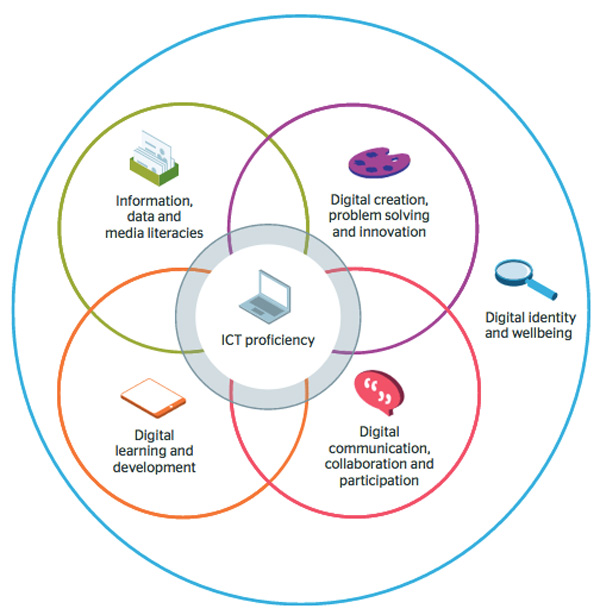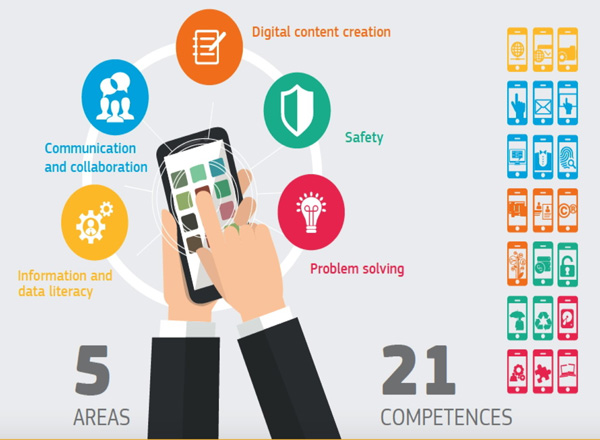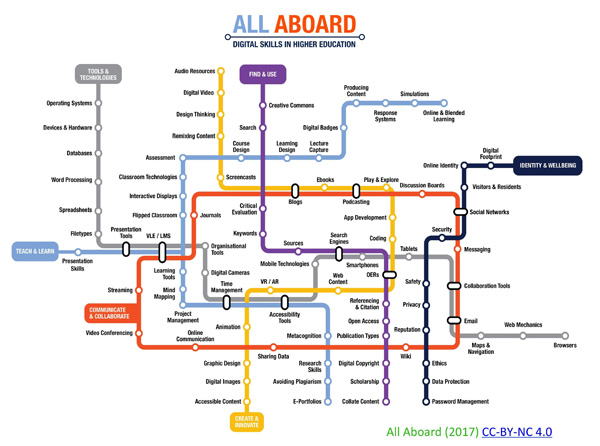By Professor Mark Brown, National Institute for Digital Learning, Dublin City University
The first part of this opinion piece finished by reporting there are over one hundred different models and frameworks claiming to describe the nature of digital literacies. Given the messy topography of the field this follow up blog post briefly describes some of the higher profile or more widely known frameworks from the United States, United Kingdom and Europe. The discussion identifies an inherent tension between universal and contextual definitions of digital literacies, and finishes with an example of a current Irish initiative. This local example (for me), and the other major models critically reviewed below, illustrate why we need to challenge some of our taken-for-granted assumptions, and metaphorically ‘get off the tracks’ in order to develop more transformative frameworks for digital literacies.
New Media Consortium
In 2016, the New Media Consortium (NMC) sought to address the lack of a common definition and develop a shared vision of digital literacies for higher education. Drawing on input from over 450 educators, Alexander, Adams Becker and Cummins (2016) produced a strategic brief reviewing the digital literacies landscape. This Horizon Report was predicated on the assumption that lack of agreement on what digital literacy comprises is impeding the development of adequate policies and efforts to implement appropriate programmes. In their review of the field the authors confirm the literature is ‘broad and ambiguous, making digital literacy a nebulous area that requires greater clarification and consensus’ (Alexander, Adams Becker & Cummins, 2016, p.1).
To provide more clarity in broad terms digital literacy was taken to mean both critical and practical understandings of digital technologies in socio-cultural settings, where people are creators as well as observers. The report then broke down digital literacy into three different models—Universal Literacy, Creative Literacy and Literacy Across Disciplines—in order to identify and expand on the different elements that make up the sum of the area. In brief, ‘universal literacy’ involves inculcating a critical stance towards the increasingly immersive world of digital technologies; ‘creative literacies’ encapsulate the producer side of the producer-consumer continuum; and the third way of thinking about digital literacy focuses on curricular infusion ‘across the disciplines’ (see Figure 2).

The three different components of digital literacy involve not just understanding how new digital tools work but also why it is useful and when to use them. This conception is described as encompassing the wider notion of digital citizenship—that is, ‘the responsible and appropriate use of technology, underscoring areas including digital communication, digital etiquette, digital health and wellness, and digital rights and responsibilities’ (Alexander, Adams Becker & Cummins, 2016, p.1). Although the report is skewed a little towards U.S. centric literature, importantly it acknowledges that definitions of digital literacy are not static, and related models and frameworks will continue to evolve.
Digital Capability Framework
In the U.K. one of the most cited efforts to develop a comprehensive framework for digital literacy comes from the work of Jisc, which in recent years has funded a number of projects and published several reports on the topic. While the language has shifted over the years from ‘literacy’ to a wider conception of ‘literacies’, and more recently to ‘digital capabilities’, and the original proposed digital literacy framework has evolved in response to the growing complexity of the field, the underlying definition remains the same—that is:
Digital literacies are those capabilities which fit an individual for living, learning and working in a digital society (Jisc, 2014, P.1).
Anchored in this definition the originally proposed Seven Elements Model of Digital Literacies included the following dimensions: (i) media literacy, (ii) communications and collaboration, (iii) career and identity management, (iv) ICT literacy, (v) learning skills, (vi) digital scholarship, and (vii) information literacy. Building on the original work of Sharpe and Beetham (2010), this model has now evolved into a Digital Capability Framework (see Figure 3) comprising of six elements—ICT proficiency; information data and media literacies; digital creation, problem solving and innovation; digital communication, collaboration and participation; digital learning and development; and digital identity and wellbeing—with 15 sub-elements recognising a combination of functional skills, critical use, creative production, participation, development, and self-actualising (Jisc, 2016; cited in Beetham, 2017).

While they propose quite different frameworks the common feature of the work of Jisc and the NMC is that digital skills, literacies and capabilities encompass both functional and critical dimensions. Moreover, the various elements of digital literacies attempt to encapsulate a wider emphasis on digital citizenship, including the notions of identity, wellbeing and rights and responsibilities. Both frameworks also acknowledge that what it means to be digitally literate changes over time, although Jisc (2014) arguably gives greater weight to the point that these changes may occur across contexts. In recognition of this point they describe digital literacies as ‘a set of situated practices supported by diverse and changing technologies’ (Jisc, 2014, P.1). That said, despite acknowledging the changing nature of digital literacies, there remains an inherent tension in both of these two high profile U.K. and U.S. initiatives between needing to accommodate local contextual factors and striving for universality.
European Digital Competence Framework
In Europe, there have also been efforts to standardize or define a universal model of digital literacies through the European Digital Competence Framework for Citizens (Vuorikari, Punie, Carretero Gomez, & Van den Brande, 2016). In 2017, the updated version of this framework, known as DigComp 2.1 (see Figure 4), identifies five key components of digital competence—information and data literacy, communication and collaboration, digital content creation, safety, and problem solving—with 21 related competences and eight proficiency levels (Carretero, Vuorikari & Punie, 2017).

The DigComp initiative was developed by the Joint Research Centre (JRC) of the European Commission through a consultation process with, and active input from, a wide range of stakeholders. The basic assumption underpinning this framework, as stated in the official DigComp Infographic, is that the ‘Digital society needs digitally-competent citizens’. In this context, according to the infographic, being digitally competent is taken to mean:
Using digital technologies in a confident and safe way for various purposes such as working, getting a job, learning, shopping online, obtaining health information, being included and participating in society, entertainment, etc (P.2).

The question is whether such a universal and all-encompassing digital competency framework can be applied across a culturally and geographically diverse region like Europe, as each individual nation varies enormously in terms of national priorities, local education system and level of technological development. There is a risk that such a comprehensive framework, which identifies quite specific competencies and proficiency levels, will be less agile to contextual differences and the changing nature of digital literacies. Although the DigComp Framework is relatively new and currently at various stages of implementation across Europe (see Figure 5), the jury is still out whether such a universal model can be applied to different cultures and contexts. In the case of the Republic of Ireland, for example, the European framework has not to date figured prominently in shaping digital developments in this area. More to the point, in many respects the framework competes with the local All Aboard initiative.
The Irish Digital Skills Framework
In Ireland, the aforementioned All Aboard (2015) project borrows and expands upon Jisc’s definition to define digital skills, literacies or competencies as ‘the capabilities which fit someone for living, learning and working in a digital society, with the knowledge that a digital society is ever evolving’ (p.18). The project then proposes a Digital Skills Framework based on a metro map comprising of six stations: (i) tools and technologies; (ii) find and use; (iii) communicate and collaborate; (iv) teach and learn; (v) create and innovate; and (vi) identity and wellbeing (see Figure 6).

While the imagery of a connected network of train lines attempts to help people make sense of an increasingly complex digital landscape there is a question of validity, as the links between stops are not always apparent and the separation of the main stations (e.g., teach and learn from tools and technologies) is potentially counter-productive to developing a more integrated approach to digital literacies. Arguably, the framework is limited by the metro metaphor, which, after all, is a 20th Century representation of a city’s transportation system. While this system may still exist even in the age of driverless car the metaphor hardly challenges us to break free of current thinking or explore new digital frontiers.
Going off the tracks
A deeper understanding of the changing nature of digital literacies–for better and worse—requires us to go off the tracks and out of the metaphorical stations, as the uncomfortable reality is that further out in our deprived suburbs and neglected rural communities we increasingly live in unequal societies where not everyone has the choice or luxury of traveling by train. This criticism is not unique to All Aboard as the observation applies to most popular conceptions of digital literacies. However, this important gap in our current conception of digital literacies is particularly apparent in the above definition originally proposed by Jisc (2014) referring to the development of capabilities which ‘fit’ an individual for the digital society. If digital literacies are core to what it means to be an educated person in the 21st Century, then our thinking needs to go beyond preparing people to fit the type of inequitable and socially unjust societies we have created over the past century. Frameworks such as All Aboard, DigComp, Digital Capability, and so on, limit our conception of digital literacies to helping people more fully participate in society; and arguably they do little to develop the type of critical knowledge and political agency to engage with, and fundamentally address, the really big issues facing humanity in the digital-era.
The third blog post in this series extends this line of discussion with a call for the development of more critical digital mindsets.
References
Alexander, B., Adams Becker, S., & Cummins, M. (2016). Digital literacy: An NMC Horizon project strategic brief. Volume 3.3, October 2016. Austin, Texas: The New Media Consortium.
All Aboard. (2015). Towards a National digital skills framework for Irish higher education: Review and comparison of existing frameworks and models. Available at http://allaboardhe.org/DSFramework2015.pdf
Beetham, H. (2017; 9th March). Digital capability framework: An update. Blog post in Jisc Digital Capability Codesign Challenge. Available at https://digitalcapability.jiscinvolve.org/wp/2017/03/09/digital-capabilities-framework-an-update
JISC. (2014). Developing digital literacies. Available at https://www.jisc.ac.uk/guides/developing-digital-literacies
Sharpe, R., & Beetham, H. (2010). Understanding students’ uses of technology for learning: towards creative appropriation. In R. Sharpe, H. Beetham & S. De Freitas (Eds.), Rethinking learning for a digital age: How learners are shaping their own experiences (pp. 85-99). London and New York: Routledge.
Vuorikari, R., Punie, Y., Carretero Gomez S., & Van den Brande, G. (2016). DigComp 2.0: The Digital Competence Framework for Citizens. Update Phase 1: The Conceptual Reference Model. Luxembourg Publication Office of the European Union.

[…] a problematic concept through political and contextual disengagement amongst society (Brown, 2017). Brown (2017) emphasises that the inability to clearly define digital literacy can limit opportunities to improve […]
[…] Brown, M. (2017b). A critical review of frameworks for digital literacy: Beyond the flashy, flimsy and faddish – part 2. http://blog.ascilite.org/a-critical-review-of-frameworks-for-digital-literacy-beyond-the-flashy-flim… […]
[…] Brown, M. (2017b). Critical review of frameworks for digital literacy: Beyond the flashy, flimsy and faddish – part 2. Retrieved from http://blog.ascilite.org/a-critical-review-of-frameworks-for-digital-literacy-beyond-the-flashy-flim… […]
[…] last few weeks, I have started to comprehend why people have found the term so difficult to define (Brown, 2017), and that is because our reliance and perspectives of the online world are increasingly complex. My […]
[…] Brown, M. (2017b). Critical review of frameworks for digital literacy: Beyond the flashy, flimsy and faddish – part 2. Retrieved from http://blog.ascilite.org/a-critical-review-of-frameworks-for-digital-literacy-beyond-the-flashy-flim… […]
[…] and critical thinking, underpinned by social emotional elements of empathy and respect (Brown, 2017b; 2017c; Lankshear & Knobel, 2008). (Examples […]
[…] Brown, M. (2017b). Critical review of frameworks for digital literacy: Beyond the flashy, flimsy and faddish – part 2. Retrieved from http://blog.ascilite.org/a-critical-review-of-frameworks-for-digital-literacy-beyond-the-flashy-flim… […]
[…] Part 2 compares and contrasts a handful of better-known digital literacy models and frameworks. […]
Hah. Thanks for this, Mark. In All Aboard we are inveterate fans of public transport.
https://www.theguardian.com/technology/2017/nov/09/self-driving-bus-crashes-two-hours-after-las-vegas-launch-truck-autonomous-vehicle
AA was developed as a simple tool to help people feel more confident, willing to explore and build a sense of getting to know the space. It’s not a framework in the formal sense. The stations and lines are simply a metaphor and not to be taken literally in terms of what goes in where. People are free to pop into any station they want, cross lines, whatever.
😉
Excellent series, and thank you for the link.
Did you see our NMC followup this past summer?